How to choose the best vehicle for overlanding and our favorite models on the market
Fuel efficiency, affordability, and ease of repair are usually the top factors die-hard wanderers look for in a car, but having a few creature comforts and the latest technology and features can make or break life on the road. And while, technically, any car can be used for overlanding, some are better suited for it than others.
Interested in overlanding? Here’s where to start and what to know
So, what’s the best vehicle for overlanding? There’s no one-size-fits-all car for overlanding. Your destination, preferred activities, and length of stay all influence the type of vehicle best for your needs—especially if it’ll be pulling double duty as a daily driver.
If you’re in the market for a new car and want something versatile for work and extended play, here are some main points to consider.
Fuel economy
New vehicle fuel economy is at a record high, with SUV crossovers achieving an average rating of 28.4 miles per gallon, according to the U.S. Environmental Protection Agency, and trucks averaging 19.2 miles per gallon. These numbers are helpful in figuring out how much it will cost to fill your gas tank and get to your destination, but some drivers need to think about how far they can travel on a full tank and the type of fuel that will be available when they get to the next gas station.
Diesel vehicles offer more torque for drivers that plan on towing trailers and deliver around 20 percent higher fuel economy than regular gasoline. While diesel fuel is typically less expensive than petrol in most countries, the opposite is true in the U.S. However, as a denser energy source, diesel extends your driving distance on a full tank, which could be important if you’re planning on going way off the beaten track.
And while luxury vehicles are flush with advanced off-roading and electronics that can make “roughing it” more bearable, they often require more expensive premium fuel that may or may not be available in remote locations, so drivers will need to plan accordingly.
Ride comfort
There’s no getting around that a majority of driving, even for overlanders, is done on pavement, which makes true the adage that the journey is as important as the destination. This means buyers should consider how comfortable a vehicle is to drive on long stretches of highway or country roads.
If enjoying the daily commute is a priority over weekend getaways, buyers should look for acoustic insulation, noise cancellation, adjustable and heated seats, and independent air suspension systems to keep engine and road noise out of the cabin (especially if you’re opting for large all-terrain tires). However, these upgrades often introduce more ways a vehicle can break.
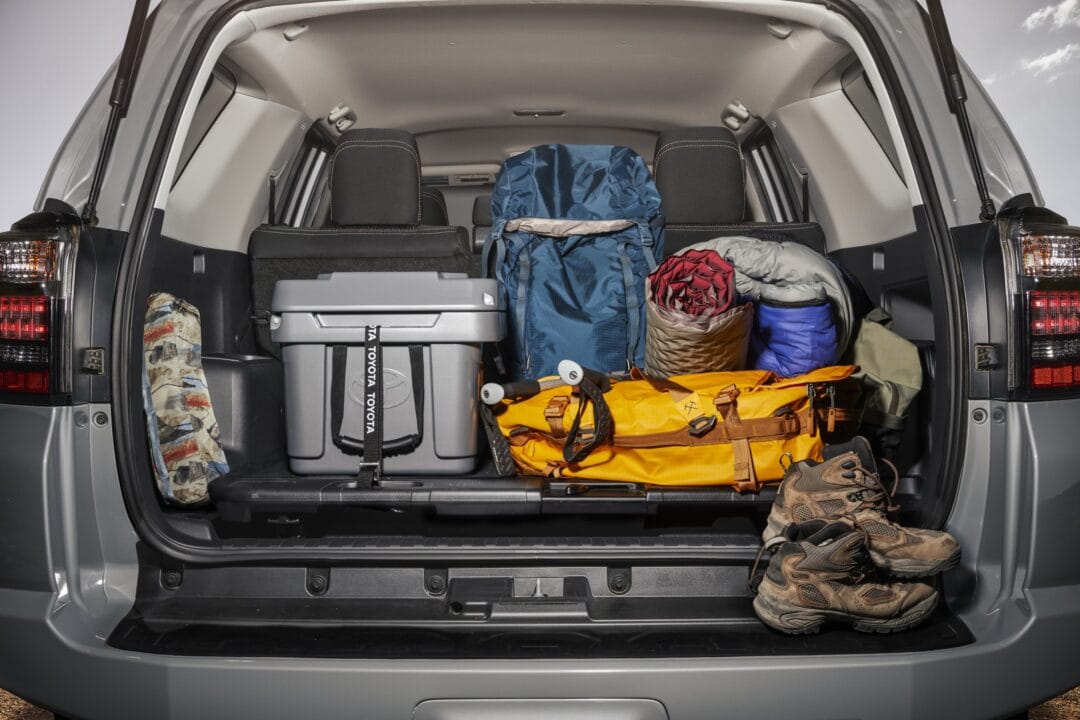
Cargo capacity
“How much gear can it carry?” is one of the more pressing questions owners have when it comes to shopping for a new overlanding rig. To maximize stowage, the ideal vehicle should have a tall, boxy cargo area with a plastic or rubber bay floor that’s easy to clean, with several tie-down areas and storage compartments for small items.
Many new vehicles also offer available 12-volt or 120-volt outlets for operating small, low-wattage appliances. After determining if your gear will fit, buyers who plan on sleeping inside the vehicle need to think about lie-flat seats and measure the cargo floor area to determine what type and size mattress to order.
20 overlanding essentials: Gear and gadgets for the ultimate off-road camping adventure
Electronics, telematics, and safety
Advanced driver assistance systems are becoming standard equipment in new vehicles, improving safety on the road. Forward automatic emergency braking, blind spot warning, and lane-keeping assistance can prevent or mitigate the severity of collisions, and adaptive cruise control is useful to alleviate some of the driving burden of traveling long distances.
While smartphones are many drivers’ preference for maps and entertainment, there’s something to be said about the convenience of having an embedded navigation system and satellite radio that works even when phones don’t.
Essential gear you need for RVing off the grid
Off-road capabilities
Most overlanding expeditions don’t call for crawling rocks, but a vehicle equipped with four-wheel drive will make it easier to get to that perfect campsite in the outer reaches of public lands, especially through rough terrain and wet or inclement weather. In addition to the ability to send power to all wheels, it’s helpful to have high ground clearance, as well as approach, breakover, and departure angles to prevent the vehicle from dragging or getting stuck on steep inclines. If you’re into rock crawling, choosing the right differential setup is important, but it’s likely not a huge factor for the average weekender.
How to off-road like a pro in your own vehicle
Payload and towing
How much gear you can carry or tow is one of the main questions people have when it comes to choosing a new overlanding vehicle. Many new SUVs leverage cameras and sensors to make it easier to hitch trailers and integrate brake lights when towing, and some offer optional trailer sway control systems that can automatically modulate engine power and apply independent wheel braking to stabilize the trailers.
In addition to towing and payload specs, shoppers should research the maximum static and dynamic load that the roof rails can support—especially if you’re planning on using a rooftop tent—and know how much your gear weighs when loaded on the vehicle.
Rig Roundup: The 6 best RVs for going off the grid
Servicing and parts availability
Reliability is an important factor to consider for overlanding vehicles. Rough terrain and long-distance driving are hard on all parts of the vehicle, especially in extreme weather. While you can bring spare parts and fluids, it’s not easy to prepare for a broken control arm or burned-out clutch. The last thing you want is to pull up to a garage in the middle of nowhere and find out it will take 6 weeks to get a part that’s back-ordered.
The best vehicles for overland adventures
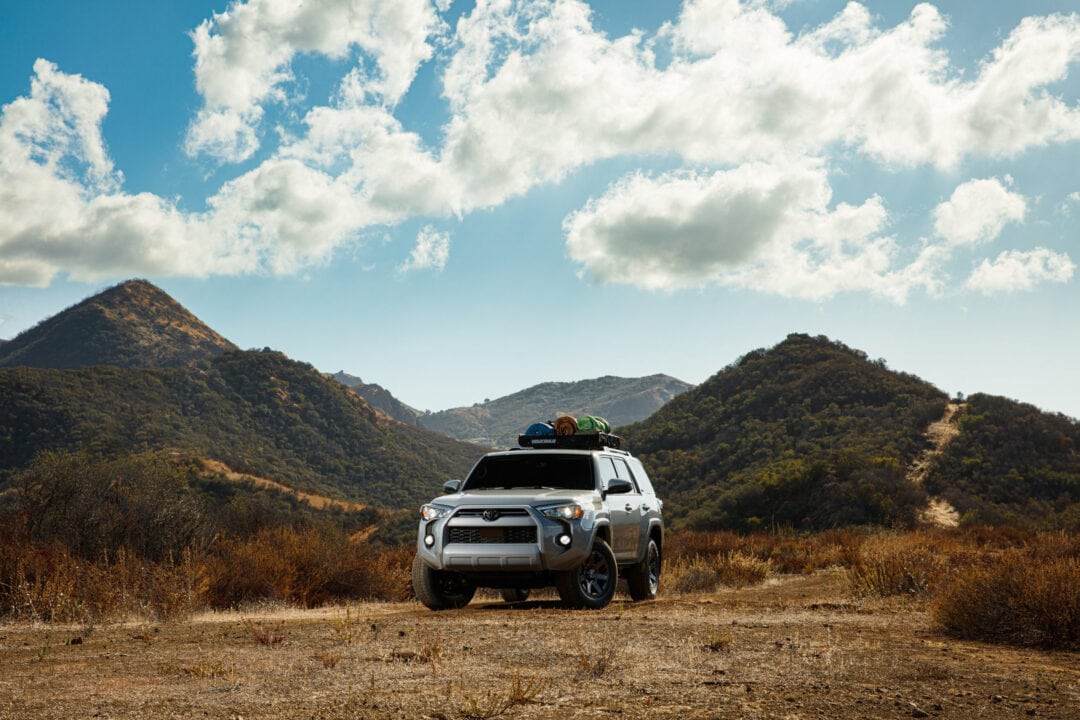
2023 Toyota 4Runner TRD Off-Road
| Passengers | 5 |
| Towing capacity | 5,000 pounds |
| Chassis | Body-on-frame |
| Ground clearance | 9.6 inches |
| Full-size spare | Yes |
| Fuel range | 16/19/17 mpg (city/highway/combined) |
| MSRP | $42,650 (plus destination fee) |
Out of the box, the 4Runner TRD is made for life off the beaten path. The trail-ready TRD models seat five (if you need the third row, stick with the SR5) and are equipped with a 4-liter V6 engine producing 270 horsepower and 278 pound-feet of torque, paired with a five-speed automatic transmission.
Four-wheel drive is standard on the Off-Road and higher trims, and all variants can tow up to 5,000 pounds. Although specs lag behind other full-sized SUVs (and the 4Runner is due for a thorough updating), the fifth-gen SUV is known to be reliable, easy to service, and is popular with aftermarket outfitters, which makes it easy to find the gear and modifications you need to convert this SUV into a proper overlanding rig.
Features and options we love:
An optional under-floor storage box below the sliding rear cargo deck is useful for storing spare parts and organizing small items, and there’s a 120-volt AC power outlet. TRD models are standard equipped with an integrated towing receiver hitch and wiring harness with 4- and 7-pin connectors.
More information on this overlanding vehicle can be found here.
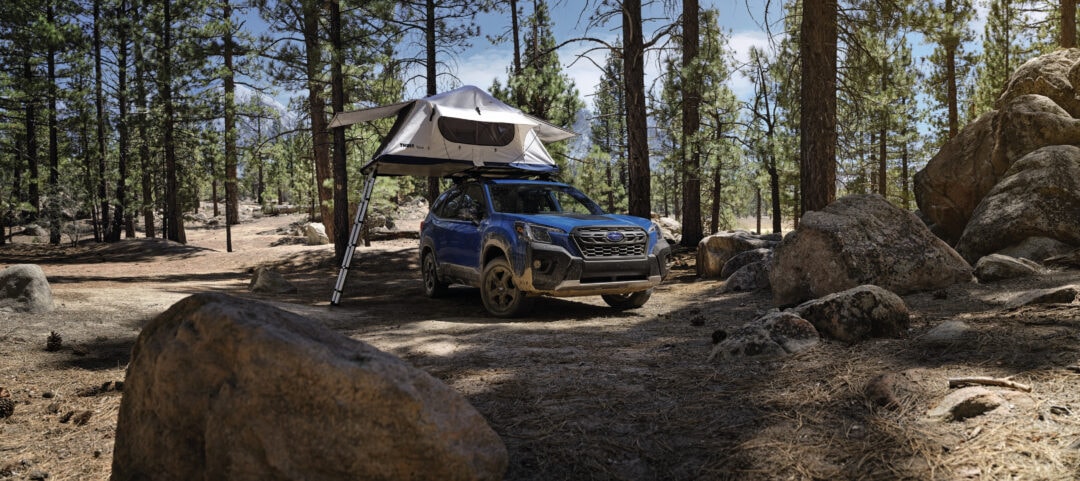
2023 Subaru Forester Wilderness
| Passengers | 5 |
| Towing capacity | 3,000 pounds |
| Chassis | Unibody |
| Ground clearance | 9.2 inches |
| Full-size spare | Yes |
| Fuel range | 25/28/26 mpg (city/highway/combined) |
| MSRP | $34,020 (plus destination fee) |
It’s hard to go wrong with a Subaru for overlanding. With higher ground clearance than most sedans, yet a lower center of gravity than many crossovers and ample stowage in the cargo area, the Forester represents the divine compromise for buyers seeking a practical and comfortable daily driver that can handle a life half spent on dirt.
The Forester Wilderness is equipped with a 2.5-liter four-cylinder engine producing 182 horsepower and 176 pound-feet of torque, and all-wheel drive is standard across the board. The Eyesight suite of advanced driver assistance features is also baked into the base price, which includes adaptive cruise control, automatic forward emergency braking, lane-keeping assistance, and other features, making the compact crossover a safe and economical choice.
Features and options we love:
Subaru’s new camping-focused Wilderness edition of the Forester raises the ground clearance from 8.7 inches to 9.2 inches, doubles the towing capacity to 3,000 pounds, adds trailer stability assist, and uses ladder rails that can support 220 pounds of dynamic weight (and up to 800 pounds of static weight)—more than enough to mount a tent for a small family. Exclusive to the Wilderness edition, the Forester also has selectable dual modes for traversing snowy and rough terrain.
More information on this overlanding vehicle can be found here.
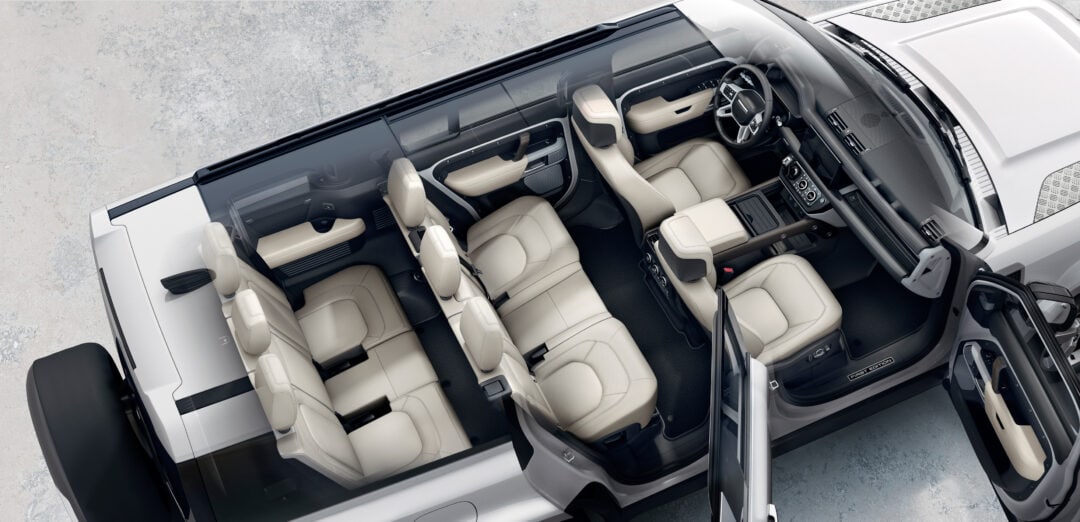
2023 Land Rover Defender 110
| Passengers | 5 |
| Towing capacity | 7,716 pounds |
| Chassis | Unibody |
| Ground clearance | 9 inches |
| Full-size spare | Yes |
| Fuel range | 18/23/20 mpg (city/highway/combined) |
| MSRP | $53,500 (plus destination fee) |
Nothing says overlanding like a kitted-out Land Rover Defender. It may not be as utilitarian as the original nameplate that launched 75 years ago, but the modern descendants are far more capable than their predecessors—and a lot more stylish and comfortable, too.
With a starting price of $53,500, you’ll get a well-equipped five-seater with a 2.0-liter twin-turbocharged four-cylinder engine producing 296 horsepower, an eight-speed automatic transmission, standard all-wheel drive, stability optimization systems, and advanced driver assistance technology. Higher trim models include larger engines with more horsepower, torque, and passenger seating, while adding additional technology, style, comfort, and convenience features.
The fun stuff is found in the many accessory packs that are tailored to outdoorsy lifestyles, especially the Explorer Pack, which includes the Expedition roof rack and exterior side-mounted gear carrier. However, adding the towing pack, off-road pack, and air suspension pack will quickly blow the budget, and that’s before you select any upgrades.
Features and options we love:
The side-hinged tailgate, sleek interior, heated front seats, off-road performance, and water wading capability—what’s not to love? But one of the most unique features of the Land Rover Defender is its integration of What3Words in its embedded navigation system, which divides the Earth’s surface into 3-meter square grids, each assigned a unique set of words. These three-word addresses can help drivers better navigate to remote or unmarked locations that typically require GPS coordinates.
More information on this overlanding vehicle can be found here.
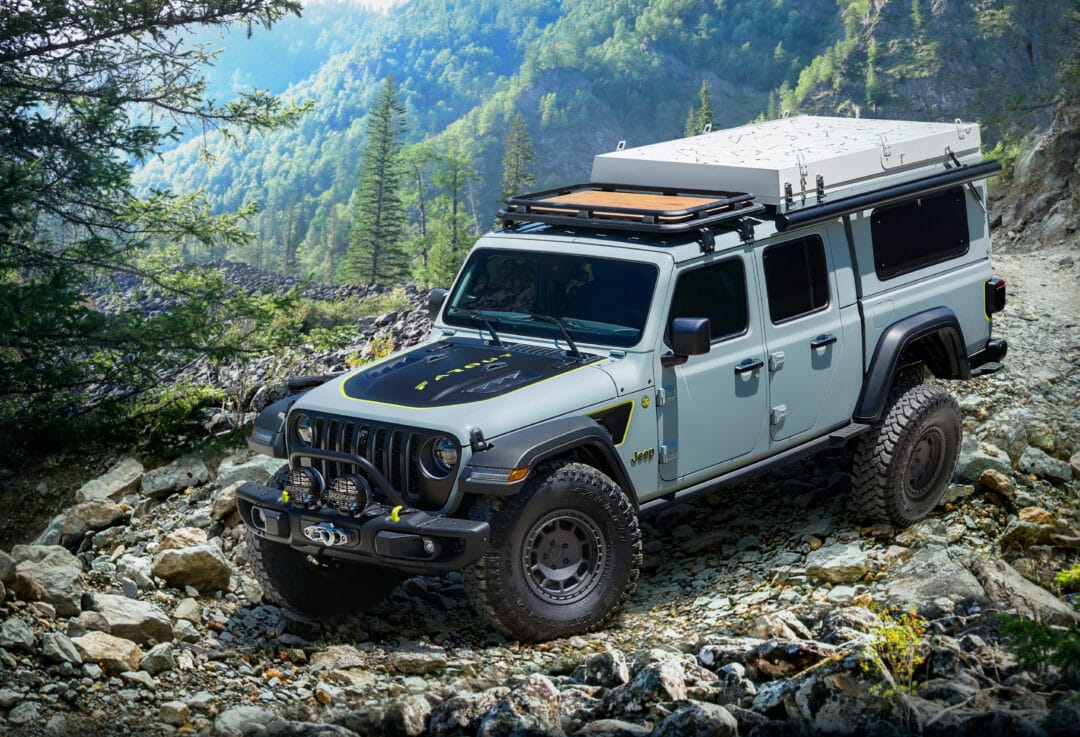
2023 Jeep Gladiator
| Passengers | 5 |
| Towing capacity | 4,000 to 6,000 pounds (up to 7,650 pounds with the Max Towing Package) |
| Chassis | Body-on-frame |
| Ground clearance | 10 to 11.6 inches |
| Full-size spare | Yes |
| Fuel range | 16/23/19 mpg (city/highway/combined; varies by trim level) |
| MSRP | Starting at $38,305 (plus destination fee) |
It’s not just a Wrangler with a longer wheelbase and chassis. Jeep underpinned the 137-inch Gladiator with a reinforced body-on-frame chassis to enable it to tow up to more than 7,000 pounds (which is almost twice as much as the Wrangler). Engine options include a standard 3.6-liter V6 engine that produces 285 horsepower and 260 pound-feet of torque, or a 3.0-liter diesel V6 engine rated at 260 horsepower and 442 pound-feet of torque.
It’s one of the few remaining vehicles that uses a six-speed manual gearbox in the base model, but an eight-speed automatic transmission is also available. In addition to its extreme durability, off-road performance cred, and utilitarian design, there’s a robust network of upfitters and aftermarket suppliers that have designed a mod or accessory for your every overlanding want or need.
Features and options we love:
Like its Wrangler cousin, the Gladiator is available with a removable roof and door kit that allows you to get the full outdoor experience. And while you won’t be sleeping in the truck bed, it’s well suited for a range of camper modules for a turn-key overlanding experience. Bonus: It’s pre-wired for four auxiliary switches under the dash and there’s a 115-volt, 400-watt power outlet in the cargo bed.
More information on this overlanding vehicle can be found here.
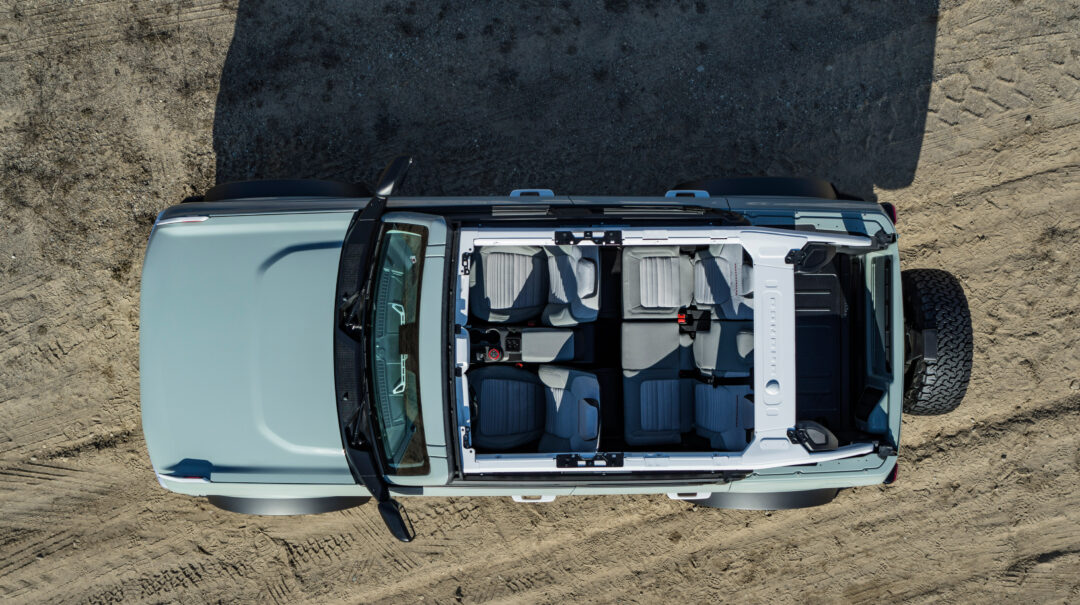
2023 Ford Bronco
| Passengers | 4 to 5 |
| Towing capacity | 2,200 to 4,500 pounds; varies by trim level |
| Chassis | Body-on-frame |
| Ground clearance | 8.4 to 11.6 inches (with base wheels) |
| Full-size spare | Yes |
| Fuel range | 20/21/20 mpg (city/highway/combined; varies by trim level) |
| MSRP | Starting at $33,890 (plus destination fee) |
The Ford Bronco is designed to make overlanding look easy. The mid-size SUV offers truck-like ruggedness with advanced off-road capabilities that almost anyone can use. It’s available in 10 trims—from bare bones to turn-key—in two- and four-door configurations, which enables Goldilocks buyers to find the perfect configuration to suit their needs. That is, if they can get their hands on one.
Supply-chain woes are hampering production for this popular off-roader, which is equipped with a 2.3-liter turbocharged four-cylinder engine producing 275 horsepower (300 horsepower with premium fuel) and paired with a seven-speed manual transmission (six, plus one crawler gear). Buyers can upgrade to a 315-horsepower, 2.7-liter turbocharged engine mated to a 10-speed automatic transmission. Selectable four-wheel drive with a terrain management system is standard on all models, as is a soft-top roof.
Features and options we love:
Off-road capability is probably the main selling point of the Ford Bronco, but in reality, it’s the heritage styling that ups the price tag. The side-hinged tailgate, rugged exterior, and removable doors and roof panels inspire wanderlust, but the SUV offers more than just a pretty fascia and chassis. A slide-out tailgate turns into a table or workspace, and rubberized flooring with an integrated drain makes the cabin easy to clean when you return to civilization.
More information on this overlanding vehicle can be found here.
Information and specs above came from dealer websites. For the most up-to-date information, check with your local dealership.